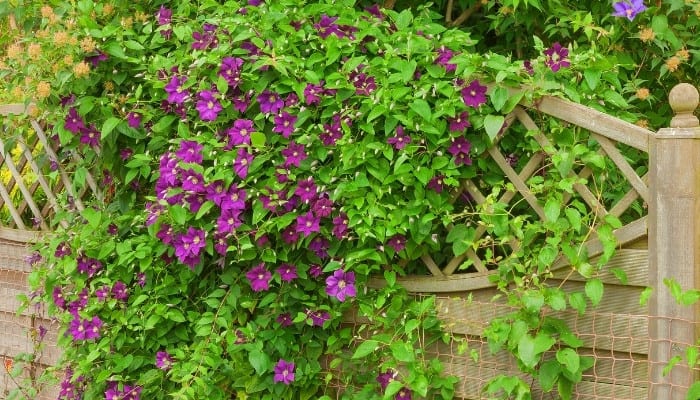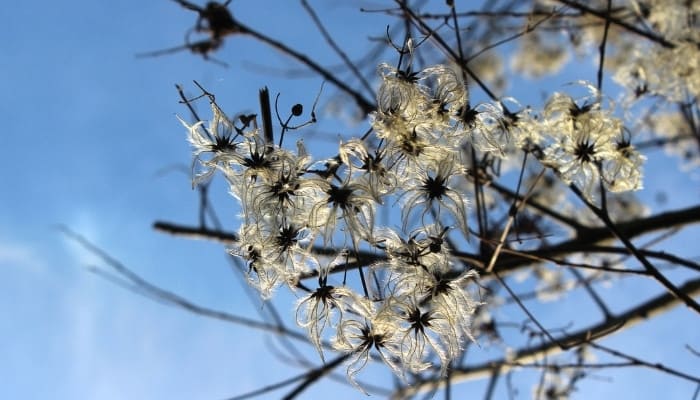In gardens, Clematis is a visually appealing plant characterized by vibrant flowers and trailing stems that provide coverage for fences, walls, and vacant areas.
For all their beauty, these plants can be a source of trouble for the beginner gardener. The plant can shed all its flowers and leaves and the stems may turn woody and brown.
Is my clematis dead? Any new bud growth means the plant is alive. If you scrape the outer bark layer and find green underneath, the plant is alive. If you bend the stems and they do not break, the plant is alive. If you examine the roots and find that they are fleshy and orange/tan in color, there is hope for the plant.
Before you take the drastic step of cutting off your clematis, you need to make sure the plant is not dead yet. Luckily, it’s easy to do that. Read on to find out if your plant can be saved.
How To Tell If Your Clematis Is Dead or Alive
When your clematis looks like a bunch of dead stems, your first impulse would be to uproot the plant and start a new one or even find another ornamental plant that doesn’t die on you so often.
However, just because the clematis looks lifeless, that doesn’t mean that it’s really dead and done for. Here are four ways to test your plant.
Bud Test
In the springtime, check the woody stems for signs of new buds. Most of the time, the leaf buds will appear on stems from the previous year.
If you prune the plant in the winter, that can accelerate the emergence of the buds next spring. Plants that haven’t been pruned might take longer to grow new leaves, so be patient.
If you’re looking for flower buds, keep in mind that the leaves will burst forth first, and flowering time can vary widely depending on the particular species.
so, at this stage, you only want to look for leaf buds; the flowers will come with time.
Stem Test
A dead stem on a clematis plant is not a pretty sight to see, but looks can be deceiving. For all intents and purposes, the clematis might be playing possum.
Hold the stem in your hand, and gently scratch the outer bark with your fingernail. Look closely underneath for signs of life – you’re looking for green wood under the outermost layer.
Even if the stem looks dry and dead, that might not be the end of the plant. Move on to the next test.
Twig Test
Giving the clematis the twig test is the easiest and least invasive way to test if the clematis is dead and gone or there’s still hope for it.
Hold the twig between your thumb and forefinger, and bend or twist it. If it breaks, the twig is dead. A live twig will bend under the pressure as it’s full of moisture.
Root Test
If all else fails and the plant still stubbornly looks, feels, and acts dead, then gently dig the top soil around the crown. The crown is the part of the clematis where the roots meet the stems.
If possible, use your hands rather than a shovel or garden fork to avoid damaging the roots.
Inspect the roots carefully. If they’re fat, fleshy, and healthy, then the plant is very much alive. It’s just dormant or has been stressed due to extreme weather conditions.
With patience and water, it will grow back and replace all those dead stems.
Can My Clematis Be Saved?
If your plant has signs of new bud growth, has green inner wood, has stems that bend instead of snap, or has a root system that appears healthy and alive, there’s a very good chance that the plant will come in the spring, provided it’s cared for properly.
You can easily keep your clematis growing and avoid that common dead phase in the plant’s life.
One way to do that is to prune the plant regularly. Because of its fast growth rate, clematis can spread out and send new stems out to cover a large area, but not all these stems make it.
Some stems will die. So cut off those dead twigs and stems at the base to trigger new growth and keep the plant looking healthy and alive.

How To Revive a Clematis
Once you have made sure that your clematis is very much alive under that woody and lifeless appearance, then you can revive it with some little work and patience.
Start by cutting all the dead stems and twigs down at the base. This might mean that you’ll have to dig under the soil sometimes to find the first live parts of the stem.
The plant will send new shoots after that. Water the plant regularly, and above all else, be patient. Sometimes clematis is slow to spring back to life.
What Does Clematis Wilt Look Like?
Wilt can be another reason why the clematis looks dead.
In this case the stems droop and look woody. Instead of the green and healthy color, the plant turns brown overnight. The leaves turn yellow and then brown before falling down.
Wilt is a fungal infection, although sometimes clematis wilt happens even when there are no signs of infection or pathogens.
Can Clematis Recover From Wilt?
Since clematis wilt only affects the foliage and doesn’t damage the roots, the plant can recover from the disease with the proper care.
Since the problem often appears when the plant is in full bloom, all the flowers for the season may fall victim to the infection.
Trim off all infected stems to prevent the spread of the disease, and give it water regularly until it grows back.
Related Questions:
How Do I Get My Clematis To Bloom All Summer?
Feed the plant with a water-soluble fertilizer with high phosphorus content and low nitrogen. Too much nitrogen can trigger foliage growth but impact the flowering.
Apply the fertilizer once in the spring and the second time in the early summer.
This fertilizer promotes blooms and also protects against a wide range of pests and pathogens – I highly recommend it.
Why Are My Clematis Bulbs Not Opening?
Too much fertilizer or using a fertilizer high in nitrogen can prevent the bulbs from opening. Young clematis plants might not flower. So be patient and avoid nitrogen-high fertilizers.
For the most part, the plant only needs fertilizing once or twice a year.
Conclusion
Although your clematis might look dead with a brown color on its leaves, stems, and twigs, the plant might be very much alive.
Clematis wilt might cause this problem, but since it doesn’t affect the roots, the plant can spring back to life with proper care.
Check that the roots are fat and fleshy, which is a sign of health. Trim off the dead stems and twigs to trigger new growth.

